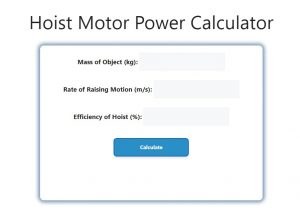About Hoist Motor Power Calculator (Formula)
The Hoist Motor Power Calculator is an essential tool for engineers and technicians involved in lifting operations. It helps calculate the power required by a hoist motor to lift a specific load efficiently. Understanding the power requirements is crucial for selecting the right motor, ensuring safety, and optimizing performance in various lifting applications. This calculator is particularly valuable in industries such as construction, manufacturing, and logistics, where hoisting equipment is commonly used.
Formula
The formula for calculating the Hoist Motor Power (HMP) is HMP = m * g * V / N, where m is the mass of the load in kilograms, g is the acceleration due to gravity (approximately 9.81 m/s²), V is the velocity of the lift in meters per second, and N is the efficiency factor of the hoist system.
How to Use
Using the Hoist Motor Power Calculator is straightforward:
- Input Mass of the Load (m): Enter the weight of the load you wish to lift in kilograms.
- Input Velocity of Lift (V): Enter the desired lifting speed in meters per second.
- Input Efficiency Factor (N): Enter the efficiency factor of your hoist system (typically between 0 and 1).
- Calculate: Click the “Calculate” button to determine the required hoist motor power.
- Read Result: The calculated power will be displayed, allowing you to assess whether your motor meets the requirements.
Example
For example, if you want to lift a load of 200 kg at a velocity of 1 m/s with an efficiency factor of 0.8, the calculation would be as follows:
- m = 200 kg
- g = 9.81 m/s² (acceleration due to gravity)
- V = 1 m/s
- N = 0.8
Using the formula:
HMP = m * g * V / N
HMP = 200 * 9.81 * 1 / 0.8
HMP = 2452.5 W
In this case, the required power for the hoist motor would be approximately 2452.5 watts or 2.45 kW.

FAQs
- What is the Hoist Motor Power Calculator?
- It’s a tool used to calculate the power required for a hoist motor based on the load and lifting speed.
- Why is calculating hoist motor power important?
- It ensures that the selected motor can handle the load effectively and safely.
- What units are used in the calculations?
- Mass is measured in kilograms (kg), velocity in meters per second (m/s), and power in watts (W).
- What is the typical value for the acceleration due to gravity (g)?
- The standard value for g is approximately 9.81 m/s².
- What does the efficiency factor (N) represent?
- It represents the efficiency of the hoist system, accounting for losses in the mechanism.
- How do I determine the efficiency factor for my hoist?
- The efficiency factor can typically be found in the manufacturer’s specifications or determined through testing.
- Can I use this calculator for different types of hoists?
- Yes, the calculator can be applied to various hoisting systems, including electric, manual, and pneumatic hoists.
- What happens if I choose a motor with insufficient power?
- An undersized motor may overheat, fail to lift the load, or pose safety hazards.
- How can I increase the efficiency of my hoist system?
- Regular maintenance, using high-quality components, and optimizing the lifting process can enhance efficiency.
- What is the relationship between load mass and required power?
- As the load mass increases, the required power also increases to lift the load at the same speed.
- How does lifting speed affect power requirements?
- Higher lifting speeds result in greater power requirements, assuming the load mass remains constant.
- What should I do if my calculated power exceeds my motor’s capacity?
- Consider upgrading to a motor with a higher power rating or reducing the load or lifting speed.
- Can this calculator be used for lifting vertical or horizontal loads?
- The calculator is primarily designed for vertical lifting but can provide insights for horizontal applications with adjustments.
- What safety considerations should I keep in mind when selecting a hoist motor?
- Always adhere to load limits, ensure proper installation, and consider safety factors in your calculations.
- Is there a minimum efficiency factor I should use?
- While a typical efficiency factor ranges from 0.6 to 1.0, always refer to your equipment specifications for guidance.
- Can I use this calculator for repetitive lifting operations?
- Yes, it’s applicable for both single lifts and repetitive operations.
- What is the significance of using SI units in these calculations?
- SI units provide a standardized measurement system, ensuring accuracy and consistency in calculations.
- Do different hoist types have varying efficiency factors?
- Yes, different hoist systems may have different efficiency factors based on their design and operation.
- What is the impact of environmental conditions on hoist performance?
- Factors like temperature, humidity, and altitude can influence motor efficiency and load capacity.
- How can I ensure accurate calculations?
- Use precise measurements for load mass and lifting speed, and verify the efficiency factor with manufacturer data.
Conclusion
The Hoist Motor Power Calculator is an invaluable tool for ensuring safe and efficient lifting operations. By understanding the relationship between load mass, lifting speed, and power requirements, users can make informed decisions about motor selection and system design. Regularly using this calculator will help maintain operational efficiency and enhance safety in various applications.